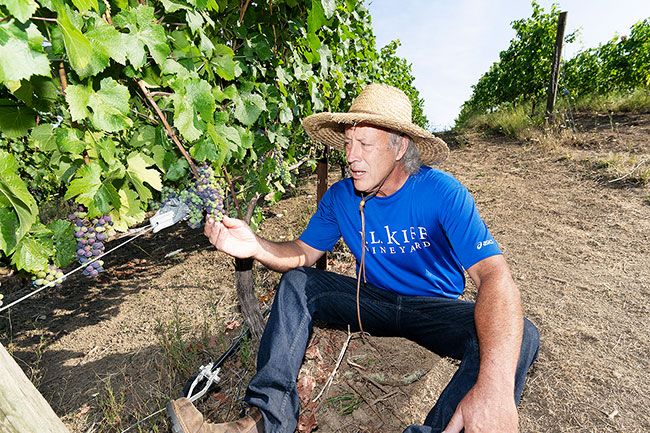Hot commodity

Grape growers say heat could lead to earlier harvest, smaller crop, more intense wines
This summer’s series of heat waves may reduce the 2021 grape harvest, but yield wines with more intense flavor, local vintners said.
During the first round in late June, temperatures soared to 113 degrees in some areas of Yamhill County. But the early extreme heat came at a good time for vineyards, several growers said. Leaves shaded the tiny grapes from sunburn and the vines went dormant for a few days, then resumed growth, they said.
The leaf canopy was still protecting the growing fruit when the next round of triple-digit heat hit in mid-July, he and other growers said. They weren’t expecting too much damage from this week’s 103- to 106-degree highs, either.
Grapes are surviving, although “we’re definitely not better off because of the hot weather; it’s not ideal,” said Sam Stetser of Atlas Vineyard Management, who manages Pearlstad Vineyard near Amity and many other vineyards.
Overall, he and other growers said, the hot, dry weather sped progress in Yamhill County’s numerous vineyards.
“Hot weather moved things forward,” said Wayne Bailey, grower and winemaker at Youngberg Hill Inn & Vineyard southwest of McMinnville.
Bailey said this week he’s already seeing veraison, a term that means grapes are ripening and changing color. He attributed the early start to the dry April and May and rains in early June, as well as the unusually hot periods over the last two months.
The 2021 crop has smaller berries and clusters than in some years, he said. Clusters of fruit may be sunburned or stop ripening as a result of this week’s intense heat.
It’s not a big problem, he said. If some grapes are damaged, “we would do a more careful selection” during harvest.
This is not the first hot summer Bailey has seen since purchasing Youngberg Hill in 2003. In that first year and 2009 and 2014, he said, heat caused the grapes to be smaller with more concentrated flavor.
“We don’t know the September weather yet,” he said. “If it stays, that suggests we’ll have lower yields, but bigger wines.”
Big flavors are welcome, he said, although ideally “we always like quality and quantity, just like with any other crop.”
Robert Moshier, general manager of the NW Wine Co. in Dundee, also is expecting a smaller harvest because of the hot summer. He said his vineyards originally were expected to produce about 5,000 tons this year, but now it’s looking more like 4,000 tons.
That’s not entirely bad, though, he said.
“It may be small, but it should be excellent,” Moshier said. Like Bailey, he expects those grapes will have more concentrated flavor.
Moshier added Wednesday that the vines looked “really healthy,” just one of several bright spots for NW Wine Co.
Moshier said he, CEO Laurent Montalieu and other employees are still celebrating the winery’s recent purchase by Casparian Partners of McMinnville and investment by the Lone Rock Resources company, based in Roseburg.
The purchase will allow NW Wine Co. to retain its current employees and expand both its vineyards and its wine-making space. The winery plans to add a 10,000-square foot building in Dundee following harvest. The next step will be expanding its tank capacity from the current 700,000 gallons, adding 200,000 gallons capacity in 2022 and another 200,000 gallons in 2023.
“We’re really excited. Our future is looking bright,” said Moshier, who’s been with the winery for 15 years.
In fact, “everyone’s excited” about the prospect for a great harvest, said Stetser, the vineyard manager at Pearlstad.
The quality looks good, he said, and winemakers are hoping there won’t be a repeat of the smoke from last September’s wildfires.
Ken Pearlman owns the site in the Eola Hills above Amity. The 18 acres of grapes are doing fine in the heat, he said.
Stetser agreed that vines are weathering the summer well, both at Pearlstad and in the other vineyards he works with in the Yamhill Valley and Willamette Valley.
But they are more susceptible to damage now than they were in June, since the fruit is now bigger and juicier.
“The vines are more stressed now anyway,” he said. “They’re putting more energy into grapes (than foliage).”
Some Yamhill County vineyards, including Pearlstad, have been watering at times. But most are not; they’re just “hoping and waiting and seeing what happens,” Stetser said.
He is trying a relatively new product in some vineyards, as well: A clay-based spray that acts as a protective layer on the leaves and vines. It washes off easily after it has done its job, he said.
Joel Kiff of J.L. Kiff Vineyards northwest of McMinnville is eschewing watering, as well.
Kiff, who grows mostly Pinot noir grapes, said his vines are well established, with deep roots. They don’t need extra water, like they did when they were first planted.
“So far, the green parts aren’t looking water-stressed,” said Kiff, who watches the vines rather than measuring the water content in the soil. “We’re not seeing too much sunburn, either.”
He’s been tempted to turn on the water, he said. “But we’d be chickening out on our dry farming.”
This has been an interesting summer, Kiff said. Usually vines shut down when the temperature hits 100 degrees, but his grapes kept building sugars even when it topped 110 in June. He had never experienced that much heat so early in his vineyard, he said.
“The vines sped up instead of the usual delay,” he said.
This week, though, it’s a different phase of the growing cycle, and he figured they would go dormant for a few days before resuming ripening. That might mean that ripening would slow down, effectively correcting for the early speed and putting harvest tune back on track.
“We usually pick in mid- to late October,” Kiff said. “We may do that this year, too.”












Comments